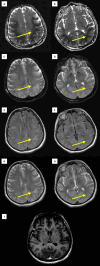Persistent Vegetative State Following a Cardiac Arrest in a Patient With Preeclampsia and Posterior Reversible Encephalopathy Syndrome: A Case Report
- PMID: 39931502
- PMCID: PMC11809669
- DOI: 10.7759/cureus.78757
Persistent Vegetative State Following a Cardiac Arrest in a Patient With Preeclampsia and Posterior Reversible Encephalopathy Syndrome: A Case Report
Abstract
We report the case of a 35-year-old female patient who presented to a tertiary referral hospital in a persistent vegetative state (PVS) following a cardiac arrest that occurred approximately one hour after an elective cesarean delivery for a postterm pregnancy complicated by preeclampsia. Magnetic resonance imaging (MRI) of the brain performed seven days after the cardiac arrest showed findings consistent with posterior reversible encephalopathy syndrome (PRES). Following transfer to our hospital, the patient was carefully evaluated, stabilized, and successfully weaned off mechanical ventilation. However, due to the lack of neurological recovery, the decision was made to transfer her to a neurorehabilitation center for further management. This case report explores the potential link between PRES and PVS.
Keywords: cardiac arrest; case report; persistent vegetative state; posterior reversible encephalopathy syndrome; preeclampsia.
Copyright © 2025, Brezic et al.
Conflict of interest statement
Human subjects: Consent for treatment and open access publication was obtained or waived by all participants in this study. Conflicts of interest: In compliance with the ICMJE uniform disclosure form, all authors declare the following: Payment/services info: All authors have declared that no financial support was received from any organization for the submitted work. Financial relationships: All authors have declared that they have no financial relationships at present or within the previous three years with any organizations that might have an interest in the submitted work. Other relationships: All authors have declared that there are no other relationships or activities that could appear to have influenced the submitted work.
Figures

References
Publication types
LinkOut - more resources
Full Text Sources
Research Materials
